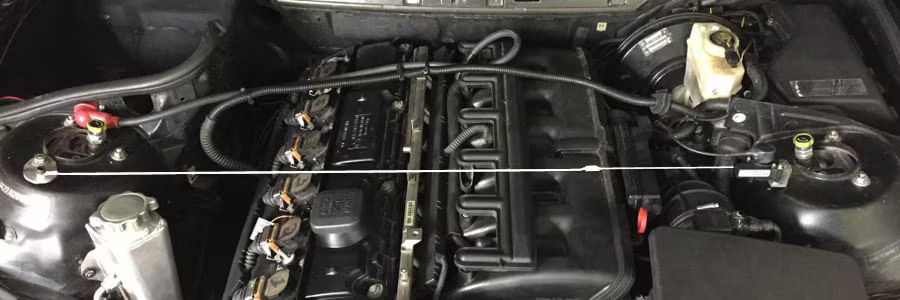|
BMW Strut Brace - Worth It?
Will A Strut Brace Help A Race Car?
When it comes to car modifications, strut tower braces have been the topic of many a great debate on the Internet. Whether for street use, track use, or additional chassis reinforcement on an already stiff and caged race car, the question always comes up: Is a strut brace worth it?
There are those who will argue to the e-death that they can feel a noticeable improvement in chassis stiffness and suspension control with a strut tower brace installed. And there are those who believe they’re nothing more than engine bay bling and eye candy. There’s plenty of conjecture but it’s extremely hard to find any actual facts to back up claims from either side. Since we love actual data to make an informed decision or recommendation, we turned off the proverbial butt dyno and measured the actual amount of strut tower deflection on a BMW. We like to go the extra mile – and we like learning just as much as we like sharing knowledge.

We wanted to get measurements on something that would see severe use, not just a street carver or beauty queen. Our test car was a BimmerWorld-built Spec E46 BMW 330i with a six-point cage (but no connection to the firewall or strut towers). We tested the same car at two different tracks - Lime Rock Park and the full course at Virginia International Raceway (VIR). VIR gave us the most usable data since it has elevation change and some significant high-loading features that really put a chassis through a workout.
Test & Data

Testing was conducted without a strut bar in place to determine “the problem” that a strut bar would otherwise solve. Nick Large, one of our Product Development Engineers, configured the onboard AiM MXL2 data system to include linear potentiometers in several configurations to measure distance changes between points. After recording on-track data, we filtered out some level of noise with an exponentially weighted moving average to get a cleaner look at the data.
The Delta Distance on the graph measures the change in distance between the tops of the strut towers, so a positive number means the towers are spreading apart while a negative number means the towers are getting closer together. Note that the measurements are in tenths of millimeters. As a rule of thumb, the distance increases during cornering because the load on the tire is twisting the top of the inside tower away from the vehicle center line, and the distance decreases under braking and over bumps because the towers twist simultaneously and in opposite directions. If you know the layout of VIR well enough, the annotations allow you to understand the trends and see how they correlate to certain sections on the track. You can see the results in the graph below.
The data was gathered over many laps, with every lap showing incredibly consistent deflection numbers, and as you can see, the movement in this measurement location is minimal on this particular caged race car. A strut bar, or any other structural member, provides strength almost exclusively in this tension/compression range, and most E30, E36, E46 BMWs exhibit movement purely laterally across the strut towers, as our measurements reflect. Further testing of additional locations showed similar minimal movement, although those locations wouldn’t typically be affected by an aftermarket strut bar regardless.
Is It Worth It or Not?
That brings us back to the main question: Is a strut brace worth it? The scientific answer is, “It depends!” Based on the data from our specific Spec E46, this race car didn’t need one on this particular test day.
But that isn’t the comprehensive answer, and from experience, we know there is a need in some cars. The older, lighter, and more flexible E30 definitely needs a strut brace, which we know from the high number of racers with collapsing strut towers that are actually pushing together with age; a strut tower brace can negate this somewhat. BMW is iterative in their chassis design - an E30, E36, and E46 share common build traits. Part of the weight gain of each new chassis is the added stiffness. But everything wears out over time, including the metal chassis of a car, so even newer models will likely head down this path eventually with enough mileage, age, and pounding on the street or track.
We’ve also seen other E46 cars bend or snap strut tower braces, which was the catalyst for this experiment, so there is clearly something moving. But remember, standard strut braces help in tension and compression, not bending, so while there is movement, a strut brace really didn’t help much in the cars where we saw damage. Previous accident damage will surely cause more issues, weakening the spot welds or sheet metal. If our test car were older, in worse shape, or if it had any broken spot welds in the strut tower, then that would have shown in the data and additional support from a strut brace would have been worthwhile.
Brace vs Reinforcement

BMW strut towers are known to deform or fatigue with alarming regularity. There are even reinforcement plates that will add thickness to the strut tower. The problem is compounded with higher spring rates and more grip. And quite a few camber plates and coil overs include top mounts with too-small upper surface area that localize forces instead of spreading the loads. In such cases a strut brace that makes full contact with the strut tower will help mitigate damage. A welded single-piece strut brace like the Rogue Engineering Race Brace will add reinforcement to the strut towers as well as disperse the energy from potholes, bumps, and severe cornering loads. Flexible or hinged braces are not expected to help much at all, especially if they don't contact all of the strut tower. Anything you can do to help distribute loads and avoid deformation of the strut towers is a plus.

Ultimately, we’d like to perform this same test after five years of racing with this car or include more cars to see a greater sample. While the movement in our graph is minimal, it may certainly be enough to have a fatigue effect over time. So it becomes a question of the added weight from an extra part versus the potential long-term benefits. That’s not as easy to answer with just one test.
| Sort by Name | Sort by Price |


